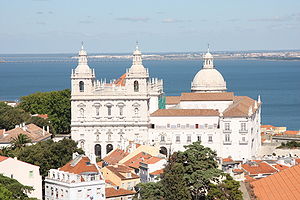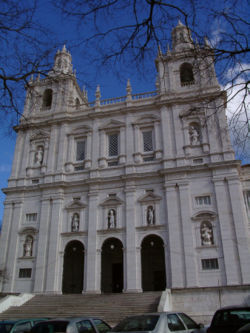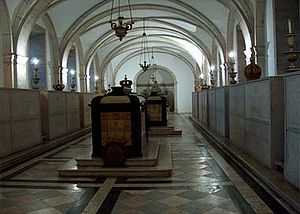
Monastery of São Vicente de Fora
Encyclopedia

Lisbon
Lisbon is the capital city and largest city of Portugal with a population of 545,245 within its administrative limits on a land area of . The urban area of Lisbon extends beyond the administrative city limits with a population of 3 million on an area of , making it the 9th most populous urban...
, in Portugal
Portugal
Portugal , officially the Portuguese Republic is a country situated in southwestern Europe on the Iberian Peninsula. Portugal is the westernmost country of Europe, and is bordered by the Atlantic Ocean to the West and South and by Spain to the North and East. The Atlantic archipelagos of the...
. It is one of the most important mannerist buildings in the country and also the burial site of most Portuguese Kings of the House of Braganza
House of Braganza
The Most Serene House of Braganza , an important Portuguese noble family, ruled the Kingdom of Portugal and its colonial Empire, from 1640 to 1910...
.
History and art
The original Monastery of São Vicente de Fora was founded around 1147 by the first Portuguese King, Afonso Henriques, for the Augustinian Order. The Monastery, built in RomanesqueRomanesque architecture
Romanesque architecture is an architectural style of Medieval Europe characterised by semi-circular arches. There is no consensus for the beginning date of the Romanesque architecture, with proposals ranging from the 6th to the 10th century. It developed in the 12th century into the Gothic style,...
style outside the city walls, was one of the most important monastic foundations in mediaeval Portugal. It is dedicated to Saint Vincent of Saragossa
Vincent of Saragossa
Saint Vincent of Saragossa, also known as Vincent Martyr, Vincent of Huesca or Vincent the Deacon, is the patron saint of Lisbon. His feast day is 22 January in the Roman Catholic Church and Anglican Communion and 11 November in the Eastern Orthodox Churches...
, patron saint of Lisbon, whose relics were brought from the Algarve to Lisbon in the 12th century.
The present buildings are the result of a reconstruction ordered by King Philip II of Spain
Philip II of Spain
Philip II was King of Spain, Portugal, Naples, Sicily, and, while married to Mary I, King of England and Ireland. He was lord of the Seventeen Provinces from 1556 until 1581, holding various titles for the individual territories such as duke or count....
, who had become King of Portugal (as Philip I) after a succession crisis in 1580. The church of the monastery was built between 1582 and 1629, while other monastery buildings were finished only in the 18th century. The author of the design of the church is thought to be the Italian Jesuit Filippo Terzi
Filippo Terzi
Filippo Terzi was an Italian military and civil architect and engineer, born in Bologna, who went to Lisbon in 1577 and the following year joined the disastrous military expedition to Morocco where he was taken prisoner at the battle of Alcácer Quibir, after which his release was negotiated and...
and/or the Spaniard Juan de Herrera
Juan de Herrera
Juan de Herrera was a Spanish architect, mathematician and geometrician.One of the most outstanding Spanish architects in the 16th century, Herrera represents the peak of the Renaissance in Spain. His sober style was fully developed in buildings like the Monastery of San Lorenzo de El Escorial...
. The plans were followed and modified by Leonardo Turriano, Baltazar Álvares, Pedro Nunes Tinoco and João Nunes Tinoco.

Renaissance
The Renaissance was a cultural movement that spanned roughly the 14th to the 17th century, beginning in Italy in the Late Middle Ages and later spreading to the rest of Europe. The term is also used more loosely to refer to the historical era, but since the changes of the Renaissance were not...
style known as Mannerism
Mannerism
Mannerism is a period of European art that emerged from the later years of the Italian High Renaissance around 1520. It lasted until about 1580 in Italy, when a more Baroque style began to replace it, but Northern Mannerism continued into the early 17th century throughout much of Europe...
. The façade, attributed to Baltazar Álvares, has several niches with statues of saints and is flanked by two towers (a model that would become widespread in Portugal). The lower part of the façade has three arches that lead to the galilee
Galilee
Galilee , is a large region in northern Israel which overlaps with much of the administrative North District of the country. Traditionally divided into Upper Galilee , Lower Galilee , and Western Galilee , extending from Dan to the north, at the base of Mount Hermon, along Mount Lebanon to the...
(entrance hall). The floorplan of the church reveals a Latin cross building with a one-aisle
Aisle
An aisle is, in general, a space for walking with rows of seats on both sides or with rows of seats on one side and a wall on the other...
d nave
Nave
In Romanesque and Gothic Christian abbey, cathedral basilica and church architecture, the nave is the central approach to the high altar, the main body of the church. "Nave" was probably suggested by the keel shape of its vaulting...
with lateral chapels. The church is covered by barrel vault
Barrel vault
A barrel vault, also known as a tunnel vault or a wagon vault, is an architectural element formed by the extrusion of a single curve along a given distance. The curves are typically circular in shape, lending a semi-cylindrical appearance to the total design...
ing and has a huge dome
Dome
A dome is a structural element of architecture that resembles the hollow upper half of a sphere. Dome structures made of various materials have a long architectural lineage extending into prehistory....
over the crossing
Crossing (architecture)
A crossing, in ecclesiastical architecture, is the junction of the four arms of a cruciform church.In a typically oriented church , the crossing gives access to the nave on the west, the transept arms on the north and south, and the choir on the east.The crossing is sometimes surmounted by a tower...
. The general design of the church interior follows that of the prototypic church of Il Gesù, in Rome
Rome
Rome is the capital of Italy and the country's largest and most populated city and comune, with over 2.7 million residents in . The city is located in the central-western portion of the Italian Peninsula, on the Tiber River within the Lazio region of Italy.Rome's history spans two and a half...
.
The beautiful main altarpiece
Altarpiece
An altarpiece is a picture or relief representing a religious subject and suspended in a frame behind the altar of a church. The altarpiece is often made up of two or more separate panels created using a technique known as panel painting. It is then called a diptych, triptych or polyptych for two,...
is a Baroque
Baroque
The Baroque is a period and the style that used exaggerated motion and clear, easily interpreted detail to produce drama, tension, exuberance, and grandeur in sculpture, painting, literature, dance, and music...
work of the 18th century by one of the best Portuguese sculptors, Joaquim Machado de Castro
Joaquim Machado de Castro
Joaquim Machado de Castro was one of Portugal's foremost sculptors. He wrote extensively on his works and the theory behind them, including a full-length discussion of the statue of D...
. The altarpiece has the shape of a baldachin
Baldachin
A baldachin, or baldaquin , is a canopy of state over an altar or throne. It had its beginnings as a cloth canopy, but in other cases it is a sturdy, permanent architectural feature, particularly over high altars in cathedrals, where such a structure is more correctly called a ciborium when it is...
and is decorated with a large number of statues. The church also boasts several fine altarpieces in the lateral chapels.
The Monastery buildings are reached through a magnificent baroque portal, located beside the church façade. Inside, the entrance is decorated with blue-white 18th century tile
Tile
A tile is a manufactured piece of hard-wearing material such as ceramic, stone, metal, or even glass. Tiles are generally used for covering roofs, floors, walls, showers, or other objects such as tabletops...
s that tell the history of the Monastery, including scenes of the Siege of Lisbon
Siege of Lisbon
The Siege of Lisbon, from July 1 to October 25, 1147, was the military action that brought the city of Lisbon under definitive Portuguese control and expelled its Moorish overlords. The Siege of Lisbon was one of the few Christian victories of the Second Crusade—it was "the only success of the...
in 1147. The ceiling of the room has an illusionistic painting executed in 1710 by the Italian Vincenzo Baccarelli. The sacristy
Sacristy
A sacristy is a room for keeping vestments and other church furnishings, sacred vessels, and parish records.The sacristy is usually located inside the church, but in some cases it is an annex or separate building...
of the Monastery is exuberantly decorated with polychromed marble and painting. The cloisters are also notable for the 18th century tiles that recount fables of La Fontaine, among other themes.

Braganza Pantheon
In 1834, after the religious orders were dissolved in Portugal, the monastery was transformed into a palace for the archbishops of Lisbon. Some decades later, King Ferdinand IIFerdinand II of Portugal
Ferdinand of Saxe-Coburg and Gotha , named Prince Ferdinand Augustus Francis Anthony of Saxe-Coburg-Gotha-Koháry, was King of Portugal as husband of Queen Maria II of Portugal from the birth of their son in 1837 to her death in 1853.In keeping with Portuguese law, only after the birth of his son in...
transformed the monks' old refectory
Refectory
A refectory is a dining room, especially in monasteries, boarding schools and academic institutions. One of the places the term is most often used today is in graduate seminaries...
into a pantheon for the kings of the House of Braganza
House of Braganza
The Most Serene House of Braganza , an important Portuguese noble family, ruled the Kingdom of Portugal and its colonial Empire, from 1640 to 1910...
. Their tombs were transferred from the main chapel to this room.
All of the Braganza kings of Portugal are buried there, from John IV
John IV of Portugal
|-|John IV was the King of Portugal and the Algarves from 1640 to his death. He was the grandson of Catherine, Duchess of Braganza, who had in 1580 claimed the Portuguese crown and sparked the struggle for the throne of Portugal. John was nicknamed John the Restorer...
(1603-1656) to Manuel II
Manuel II of Portugal
Manuel II , named Manuel Maria Filipe Carlos Amélio Luís Miguel Rafael Gabriel Gonzaga Francisco de Assis Eugénio de Bragança Orleães Sabóia e Saxe-Coburgo-Gotha — , was the last King of Portugal from 1908 to 1910, ascending the throne after the assassination of his father and elder brother Manuel...
(1889-1932), except for three:
- Maria IMaria I of PortugalMaria I was Queen regnant of Portugal and the Algarves from 1777 until her death. Known as Maria the Pious , or Maria the Mad , she was the first undisputed Queen regnant of Portugal...
is buried in the Estrela Basilica in Lisbon; - Pedro IV, also known as Emperor Pedro I of Brazil, is buried in São PauloSão PauloSão Paulo is the largest city in Brazil, the largest city in the southern hemisphere and South America, and the world's seventh largest city by population. The metropolis is anchor to the São Paulo metropolitan area, ranked as the second-most populous metropolitan area in the Americas and among...
, BrazilBrazilBrazil , officially the Federative Republic of Brazil , is the largest country in South America. It is the world's fifth largest country, both by geographical area and by population with over 192 million people...
; and - Maria Pia of SavoyMaria Pia of SavoyMaria Pia of Savoy was a Portuguese Queen consort, spouse of King Luís I of Portugal. On the day of her baptism, Pope Pius IX, her godfather, gave her a Golden Rose. Maria Pia was married to Luís on the 6 October 1862 in Lisbon...
, queen consort of King Luís I of PortugalLuís I of Portugal|-...
, is buried in the Pantheon of the House of SavoyHouse of SavoyThe House of Savoy was formed in the early 11th century in the historical Savoy region. Through gradual expansion, it grew from ruling a small county in that region to eventually rule the Kingdom of Italy from 1861 until the end of World War II, king of Croatia and King of Armenia...
in the Basilica of SupergaBasilica of SupergaThe Basilica of Superga is a church in the vicinity of Turin.It was built from 1717 to 1731 for Victor Amadeus II of Savoy by Filippo Juvarra, at the top of the hill of Superga, to fulfill a vow the duke had made during the Battle of Turin...
near TurinTurinTurin is a city and major business and cultural centre in northern Italy, capital of the Piedmont region, located mainly on the left bank of the Po River and surrounded by the Alpine arch. The population of the city proper is 909,193 while the population of the urban area is estimated by Eurostat...
, Piedmont, Italy.
Life-sized mourning statues stand by the tombs of King Carlos I
Carlos I of Portugal
-Assassination:On 1 February 1908 the royal family returned from the palace of Vila Viçosa to Lisbon. They travelled by train to Barreiro and, from there, they took a steamer to cross the Tagus River and disembarked at Cais do Sodré in central Lisbon. On their way to the royal palace, the open...
and his heir, Prince Luís Filipe
Luís Filipe, Duke of Braganza
-Titles and Styles:*21 March 1887-19 October 1889 - His Royal Highness The Prince of Beira, Duke of Barcelos*19 October 1889-1 February 1908 - His Royal Highness The Prince Royal of Portugal, Duke of Braganza-Arms:...
, who were assassinated in Lisbon in 1908 by radical Republicans.

